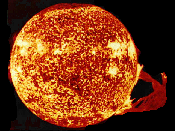 Seasons
Seasons
An Experimental Internet Based Lesson in Determining the Cause
of Seasons
Copyright 1998 by
James P. Riser
Purpose:
My "Seasons" experimental internet based lesson
was developed as a simulation to allow students practice in the following
science related skills:
- identifying a problem

- designing an experiment to test an hypothesis
- measuring distance (length), angles, and voltage
- working with limited resources (data and apparatus)
- using lab apparatus to collect data
- using the internet as a valuable resource
- identifying pertinent data from extraneous materials
- solving problems
- using ratios to help develop an experiment
- working on a research team
- recording data
- analyzing data
- drawing conclusions
- presenting their experimental findings in an organized manner
Hopefully, I have accomplished the above purposes.
Lab setup:
This activity was designed to be a modular activity through which
the students rotate. Two students work as a research team in a darkened
area of the lab. The students must be left alone to solve their own problems
and design their own experiments. This type of situation can be very difficult
and frustrating for students who are used to merely memorizing information.
This activity involves higher level thinking which is much more difficult.
You will probably find that many of the non-traditional learners do very
well with this type of hands-on activity. The "mentally challenged"
and "lazy" will not have a clue or will beg to just do some "write
definitions/answer questions" type of book work.
Assessment:
This type of lab activity is assessed on an individual team basis.
Since there are many variables in how the research teams decide to set up
their experiments to test the two theories, these decisions and the actual
design of the experiments, measurements (results), and conclusions need
to be considered.
It must be understood that I want my students to master skills
and thought processes. Therefore, I do not give a "vocabulary"
test to determine if they know such words as "orbit", "ellipse",
etc. The concept behind these terms is more important than definitions.
In my opinion, if the students are able to successfully complete this activity,
then they understand what is happening with "orbit", "ellipse",
etc. This type of assessment involves working with the students during the
assessment phase rather than just throwing a paper test at them. Since I
dislike worthless and unnecessary paper pushing, this assessment method
suits me just fine .
I like to sit down with each team and talk over which bits of
information (from the URLs and their lab results) were deemed most useful
(and why) in their quest for the better theory. During this interview, I
am looking for evidence of the skills listed at the top of this page and
relisted here:
- identifying a problem
- designing an experiment to test an hypothesis
- measuring distance (length), angles, and voltage
- working with limited resources (data and apparatus)
- using lab apparatus to collect data
- using the internet as a valuable resource
- identifying pertinent data from extraneous materials
- solving problems
- using ratios to help develop an experiment
- working on a research team
- recording data
- analyzing data
- drawing conclusions
- presenting their experimental findings in an organized manner
Due to the nature of this real life type of simulation, not every
skill on the list will be practiced by all teams. The design of their individual
experiments will affect which skills get used. I am looking for organized
thought, evidence of scientific method, variable handling, careful measurements,
logical analysis of results, and conclusions which follow from the results.
In addition I am concerned about how well the team worked together, how
well they sifted through the information from the various URLs, and how
well they presented their findings. This is not an easy activity and it
requires a non-traditional form of assessment due to the many variables
involved.
Click here to see the results of a team of
my 8th graders who attemped this project
Click here to view the results of Patti's
two 6th graders(who worked at home on this)
Click here to go to The Seasons Activity
 Seasons
Seasons Seasons
Seasons